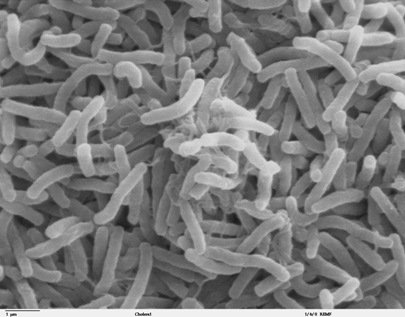Cholera is an acute intestinal infection caused by ingestion of food or water contaminated with the bacterium Vibrio cholerae .
Cholera remains a global threat and is one of the key indicators of social development. While the disease no longer poses a threat to countries with minimum standards of hygiene, it remains a challenge to countries where access to safe drinking water and adequate sanitation cannot be guaranteed. Almost every developing country faces cholera outbreaks or the threat of a cholera epidemic
Pathogenic agent
Vibrio cholerae (O-group 1 or O-group 139) is a gram negative bacterium with a curved-rod shape that causes cholera in humans. It and other species of the genus Vibrio belong to the gamma subdivision of the Proteobacteria . There are two major strains of V. cholerae, classic and El Tor, and numerous other serogroups.

This file has been released into the public domain by the copyright holder, its copyright has expired, or it is ineligible for copyright. This applies worldwide.
V. cholerae colonizes the gastrointestinal tract, where it adheres to villous absorptive cells via filaments, and secretes a Binary toxin, called cholera toxin (CT). The two CT subunits are named A and B, and are synthesised in a 1:5 ratio. The bacterium was first isolated as the cause of cholera by Italian anatomist Filippo Pacini in 1854, but his discovery was not widely known until Robert Koch, working independently thirty years later, publicized the knowledge and the means of fighting the disease.
Transmission
Cholera is transmitted through ingestion of feces contaminated with the bacterium. The contamination usually occurs when untreated sewage is released into waterways, affecting the water supply, any foods washed in the water, and shellfish living in the affected waterway person-to-person transmission is rare.
Vibrio cholerae can survive on a variety of foodstuffs for up to five days at ambient temperature and up to 10 days at 5-10°C. The organism can also survive freezing. Low temperatures, however, limit proliferation of the organism and thus may prevent the level of contamination from reaching an infective dose.
Symptoms
Symptoms include those of general GI tract upset, including profuse diarrhea. Symptoms are caused by the enterotoxins that V. cholerae produces. The main enterotoxin, known as cholera toxin, interacts with G proteins and cyclic AMP in the intestinal lining to open ion channels. As ions flow into the intestinal lumen, water follows through osmosis.
It has a short incubation period, from less than one day to five days, and produces an enterotoxin that causes a copious, painless, watery diarrhoea that can quickly lead to severe dehydration and death if treatment is not promptly given. Vomiting also occurs in most patients.
The infection is often mild and self-limited or subclinical. Most persons infected with V. cholerae do not become ill, although the bacterium is present in their faeces for 7-14 days. When illness does occur, about 90% of episodes are of mild or moderate severity and are difficult to distinguish clinically from other types of acute diarrhoea. Less than 10% of ill persons develop typical cholera with signs of moderate or severe dehydration. Patients with severe cases respond dramatically to simple fluid- and electrolyte-replacement therapy.
More information about :
